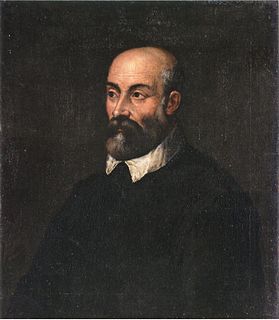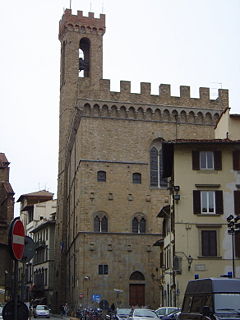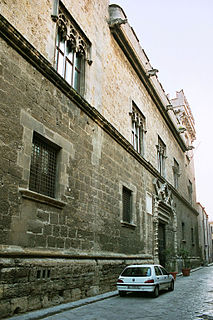
Florence is a city in Central Italy and the capital city of the Tuscany region. It is the most populated city in Tuscany, with 383,084 inhabitants in 2013, and over 1,520,000 in its metropolitan area.

Reggio di Calabria, commonly known as Reggio Calabria(listen) or simply Reggio in Southern Italy, is the largest city and the most populated comune of Calabria. It is the capital of the Metropolitan City of Reggio Calabria and the seat of the Regional Council of Calabria.

Messina is the capital of the Italian Metropolitan City of Messina. It is the third largest city on the island of Sicily, and the 13th largest city in Italy, with a population of more than 231,000 inhabitants in the city proper and about 650,000 in the Metropolitan City. It is located near the northeast corner of Sicily, at the Strait of Messina, opposite Villa San Giovanni on the mainland, and has close ties with Reggio Calabria. According to Eurostat the FUA of the metropolitan area of Messina has, in 2014, 277,584 inhabitants.

Antonello da Messina, properly Antonello di Giovanni di Antonio, but also called Antonello degli Antoni and Anglicized as Anthony of Messina, was a Sicilian painter from Messina, active during the Early Italian Renaissance. His work shows strong influences from Early Netherlandish painting, although there is no documentary evidence that he ever travelled beyond Italy. Giorgio Vasari credited him with the introduction of oil painting into Italy. Unusually for a south Italian artist of the Renaissance, his work proved influential on painters in northern Italy, especially in Venice.

Todi is a town and comune (municipality) of the province of Perugia in central Italy. It is perched on a tall two-crested hill overlooking the east bank of the river Tiber, commanding distant views in every direction.

Andrea Palladio was an Italian Renaissance architect active in the Venetian Republic. Palladio, influenced by Roman and Greek architecture, primarily Vitruvius, is widely considered to be one of the most influential individuals in the history of architecture. While he designed churches and palaces, he was best known for country houses and villas. His teachings, summarized in the architectural treatise, The Four Books of Architecture, gained him wide recognition.

Filippo Juvarra was an Italian architect, active in a late-Baroque style, who worked primarily in Italy, Spain, and Portugal.

The Bargello, also known as the Palazzo del Bargello, Museo Nazionale del Bargello, or Palazzo del Popolo, is a former barracks and prison, now an art museum, in Florence, Italy.

Piazza della Signoria is an L-shaped square in front of the Palazzo Vecchio in Florence, Italy. It was named after the Palazzo della Signoria, also called Palazzo Vecchio. It is the main point of the origin and history of the Florentine Republic and still maintains its reputation as the political focus of the city. It is the meeting place of Florentines as well as the numerous tourists, located near Palazzo Vecchio and Piazza del Duomo and gateway to Uffizi Gallery.

Antonello Gagini (1478–1536) was an Italian sculptor of the Renaissance, mainly active in Sicily and Calabria.

The Turin Civic Museum of Ancient Art is a museum located in the Palazzo Madama palace, in Turin, Italy.

The Doge's Palace is a historical building in Genoa, northern Italy.

Palazzo Abatellis is a palace in Palermo, Sicily, southern Italy, located in the Kalsa quarter. It is home to the Galleria Regionale della Sicilia, the Gallery of Art for the Sicilian region.

The Royal Palace of Milan was the seat of government in the Italian city of Milan for many centuries. Today, it serves as a cultural center and it is home to international art exhibitions. It spans through an area of 7,000 square meters and it regularly hosts modern and contemporary art works and famous collections in cooperation with notable museums and cultural institutions from across the world. More than 1,500 masterpieces are on display annually.

The Palazzo del Viminale is a historic palace in Rome (Italy), seat of the Prime Minister and of the Ministry of Interior since 1925; in 1961 the Prime Minister was transferred to Palazzo Chigi.

Genoa is the capital of the Italian region of Liguria and the sixth-largest city in Italy. In 2015, 594,733 people lived within the city's administrative limits. As of the 2011 Italian census, the Province of Genoa, which in 2015 became the Metropolitan City of Genoa, had 855,834 resident persons. Over 1.5 million people live in the wider metropolitan area stretching along the Italian Riviera.
Vincenzo Monaco was an Italian architect who collaborated with Amedeo Luccichenti from 1933 to 1963. During this period, Monaco designed more than 450 projects, of which approximately 100 were built. His work can be seen in buildings in Rome, Pisa, Naples, and Taranto, as well as in Dalmatia, Iran, France, and Tunisia.
The following is a timeline of the history of the city of Messina, Sicily, Italy.

The Museo Interdisciplinare Regionale (MuMe). or Regional Museum of Messina, is an art museum located on the northern coast of the city of Messina, Sicily, Italy.

The Palazzo San Sebastiano is a 16th-century palace in Mantua. Built by the Gonzaga family, since 19 March 2005 it has housed Mantua's city museum.


























